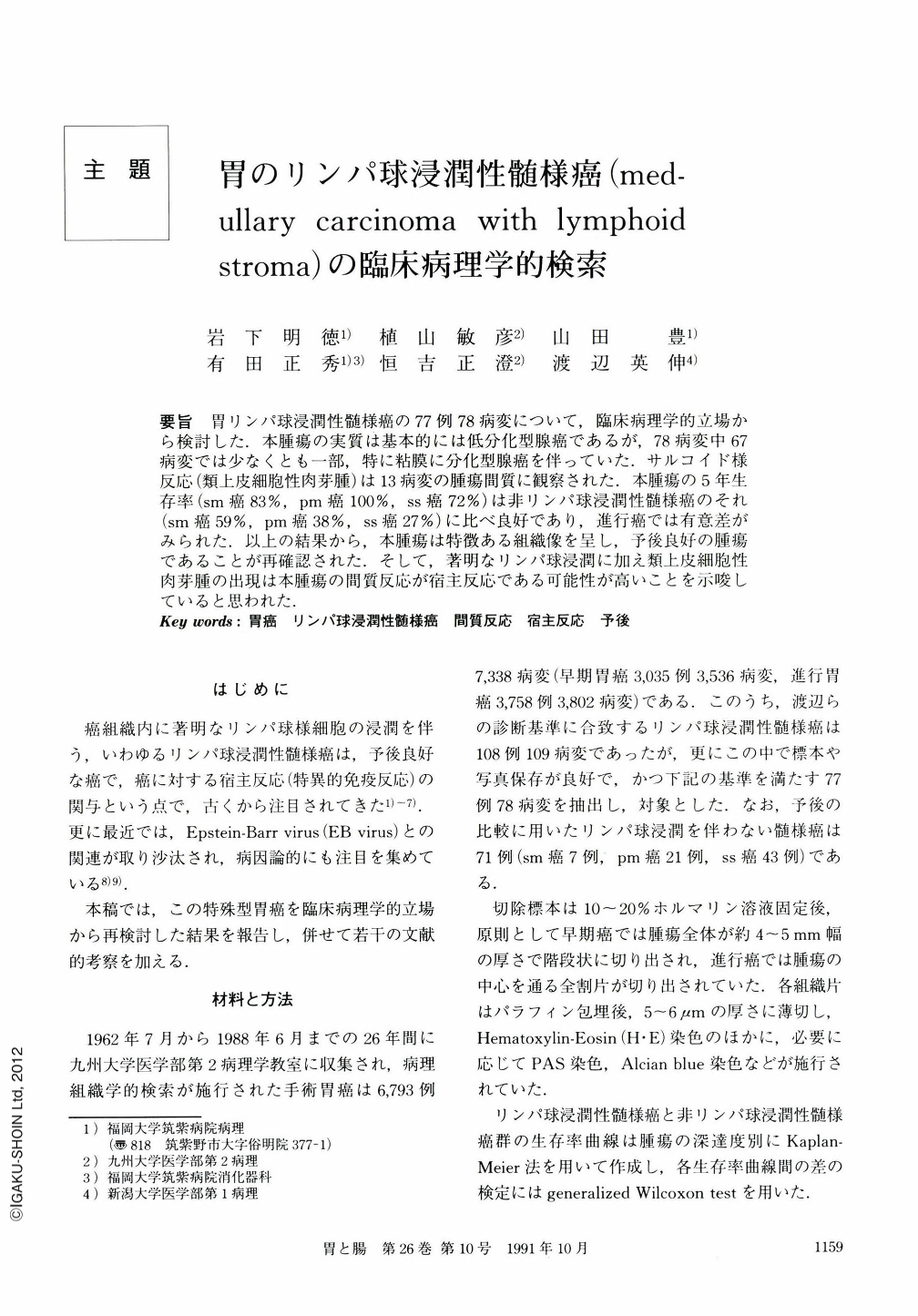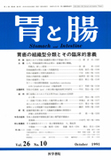Japanese
English
- 有料閲覧
- Abstract 文献概要
- 1ページ目 Look Inside
- サイト内被引用 Cited by
要旨 胃リンパ球浸潤性髄様癌の77例78病変について,臨床病理学的立場から検討した.本腫瘍の実質は基本的には低分化型腺癌であるが,78病変中67病変では少なくとも一部,特に粘膜に分化型腺癌を伴っていた.サルコイド様反応(類上皮細胞性肉芽腫)は13病変の腫瘍間質に観察された.本腫瘍の5年生存率(sm癌83%,pm癌100%,ss癌72%)は非リンパ球浸潤性髄様癌のそれ(sm癌59%,pm癌38%,ss癌27%)に比べ良好であり,進行癌では有意差がみられた.以上の結果から,本腫瘍は特徴ある組織像を呈し,予後良好の腫瘍であることが再確認された.そして,著明なリンパ球浸潤に加え類上皮細胞性肉芽腫の出現は本腫瘍の間質反応が宿主反応である可能性が高いことを示唆していると思われた.
Clinicopathological study on medullary carcinoma with lymphoid stroma of the stomach was carried out in 78 surgically resected specimens obtained from 77 patients. The results obtained were as follows.
1) Out of a total of 7,338 gastric carcinomas examined, 78 (1.06%) were identified as medullary carcinoma with lymphoid stroma. Forty-four of those 78 tumors were early gastric carcinoma, accounting for 1.24% of a total of 3,536 early gastric carcinomas examined. The remaining 34 tumors were advanced carcinomas, accounting for O.89% of a total of 3,802 advanced carcinomas.
The average age was 57.8 years and male to female ratio, 3.8 to 1. The medullary carcinoma with lymphoid stroma was most frequently observed in the fundic area.
2) Twenty-four out of 44 early carcinomas were Ⅱc type, and fourteen and ten out of 34 advanced carcinomas were Borrmann 2 type, and 3 type, respectively. The cut surface of the carcinoma was homogeneously gray-white, elastic soft in consistency and clearly demarcated.
3) The incidence of lymph node metastasis was 19.6% (11 cases) in all 56 gastric carcinoma cases examined, and O% in 29 early carcinoma cases and 40.7% (11 cases) in 27 advanced carcinoma cases.
4) The tumor was composed essentially of small and medium-sized, polygonal epithelial cells with scant faintly basophilic and/or eosinophilic cytoplasms and round vesicular nuclei with nucleoli arranged in thin trabecular, microalveolar and primitive tubuloglandular patterns. Limited areas of differentiated adenocarcinoma were found in 67 of 78 lesions, especially where tumor cells were spreading intramucosally.
The stroma of the tumor consisted of a nondesmoplastic delicate connective tissue infiltrated uniformly with an abundance of lymphocytes and plasma cells throughout the area of the tumor.
5) Sarcoid-like reaction forming small epithelioid cell granulomas was found in the stroma in 13 lesions.
6) The 5-year survival rates according to depth of vertical tumor invasion in medullary carcinoma with lymphoid stroma were 83% for cases with submucosal invasion, 100%for cases with muscle coat invasion, and 72% for cases with serosal invasion, respectively. On the other hand, those in medullary carcinoma without lymphoid stroma were 59% for cases with submucosal invasion, 38% for cases with muscle coat invasion, and 27% for cases with serosal invasion, respectively. The difference between the lymphoid and non-lymphoid stroma groups was statistically significant in the cases with muscle coat and serosal cancer invasion.
According to the results obtained, it was shown that medullary carcinoma with lymphoid stroma of the stomach has its own histologic characteristic and a favorable postoperative prognosis, and that the presence of sarcoid-like reaction in the stroma in addition to prominent lymphocyte infiltrate supports the theory that stromal reaction in this tumor represents host response.

Copyright © 1991, Igaku-Shoin Ltd. All rights reserved.


